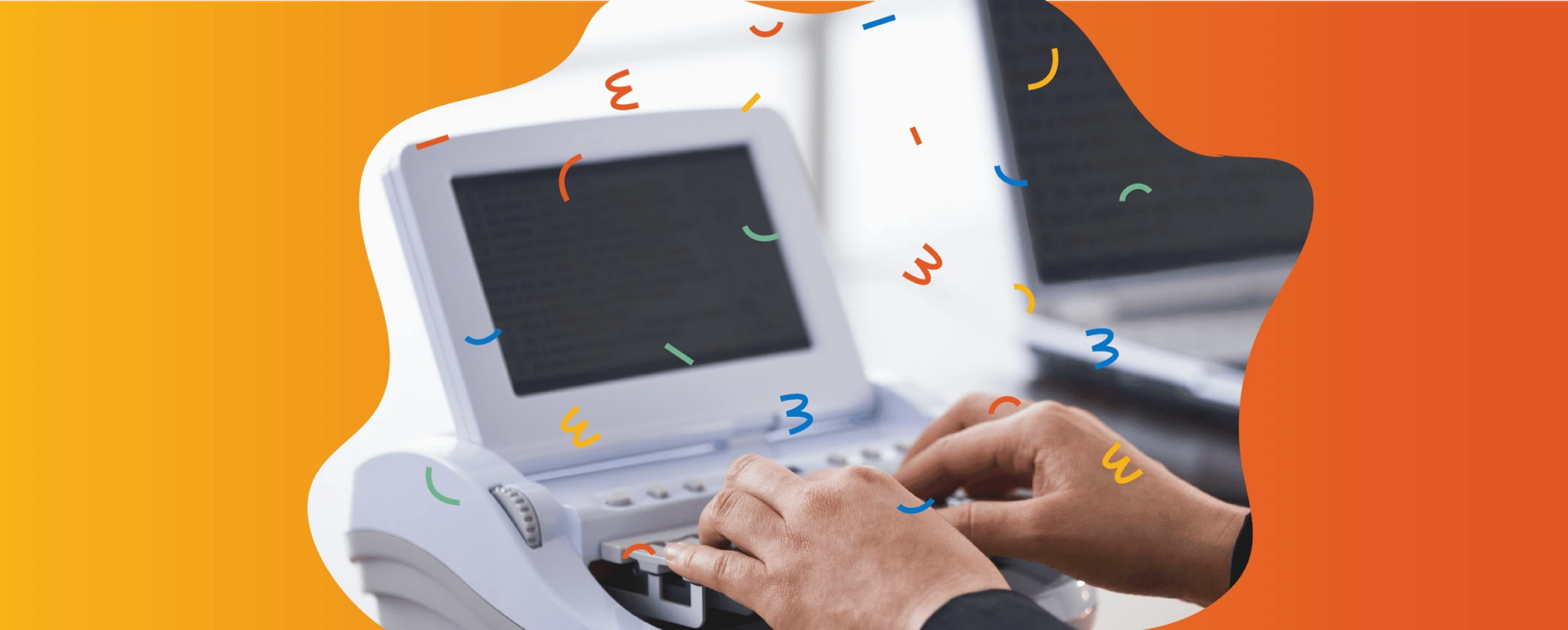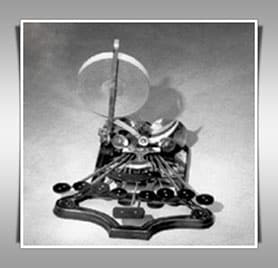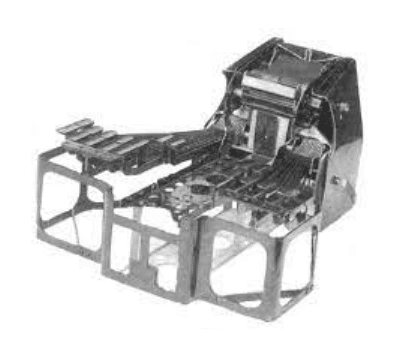Celebrating Stenography:
Where It Started and How It’s Changed Over Time

Stenography dates back to the mid-4th century BC when it was introduced as a unique, abbreviated language to enhance swift communication. Fast-forwarding to the late 19th century, the development of stenography (steno) machines provides a quicker, more accurate court reporting experience. To this day, stenography remains a core method for court reporting in depositions, hearings, trials, and other proceedings.
What is stenography and how did stenography survive millenniums of technological advancement? Why did the legal system adopt the technology and methodology of the steno machine?
Let’s revisit the past as we celebrate where stenography started and how it’s evolved to where it is today.
The Origins of Stenography
The most basic, ancient form of stenography began in 450 BC. But back then, it had another name: cuneiform.
This was similar to “caveman” writing, almost like the Egyptians’ hieroglyphics. Unlike the English language, which assigns words with letters and gives each letter an individual sound, cuneiform groups sounds together and assigns them to symbols. The symbols were then assigned a picture, and this shorter, graphic-telling communication was not only understandable and easy to teach but also timely and efficient to produce.
Several centuries later, China reinvented cuneiform and turned it into what we now call shorthand. The Chinese are the first reported culture to adopt an abbreviated language for court reporting. Court data, including confessionals, were written in grass and mud, with those shorthand notes later copied as legal documents.
Rome adopted shorthand for their legal systems as well, and Greece quickly picked up the trend. From there, after both eastern and western cultures were introduced to the art, abbreviating branched out to other forms of business and was later practiced in the common household.
Published shorthand systems first appeared in the late 1500s and are still around today. If you’d like to explore using a handwritten shorthand system, check out1:
- Pitman
- Gregg
- Speedwriting
Technological Evolution
In 1877, Miles Bartholomew invented the first shorthand stenograph machine, and several decades later, Ward Stone Ireland, an American court reporter, invented a commercial stenography device that included a keyboard and steno paper.2

IMAGE: The first stenograph machine for court reporters invented by Miles Bartholomew.
A member of the machine reporting team during the infamous Lindbergh baby kidnapping trial of 1933, Walter Heironimus, is revered today as an American court reporting pioneer. Many believe he was the first to introduce the United States to an original shorthand machine.

IMAGE: Smith stenograph invented by court reporting pioneer, Walter Heironimus.
By the mid-nineties, high-profile cases like the O.J. Simpson trial showcased stenographers on public television for the first time. Their role in a court case became more understood by the public and plays a vital role in all legal proceedings and political broadcasts.
Role and Importance of Court Stenographers
The history of stenography isn’t only about machinery—the unique skills and role of stenographers in legal proceedings have been critical to accurately record and maintain the building blocks of civil and criminal law.
Court stenographers are responsible for:
- Capturing spoken words verbatim
- Using established rules on how to represent stutters, filler words, and interruptions
- Interrupting proceedings to clarify mumbles, spelling, and nonverbal communication
- Entering nonverbal notes to reflect who’s speaking, and Q&A structure
- Monitoring functionality of steno device, software, and recording and other features
- Reviewing draft transcripts and correcting any errors
Although stenography and court reporting are two unique roles, they are commonly filled by the same individual. A court reporter is an official representative of the court who is licensed by the state, is a sworn public notary, and has undergone training and/or certification in addition to the skills—most commonly, stenography—that enable them to turn spoken words into an official transcript.
These responsibilities include:
- Establishing the official start and end of legal proceedings
- Swearing in witnesses as an officer of the court
- Following state, federal, and court jurisdictional legal proceeding standards
The official records that are created by court stenographers are the building blocks of law both for a particular case and for how laws continue to be established and interpreted going forward. They’re critical for:
- Impeaching witnesses for perjury
- Appealing judgments
- Citing past precedents to support a legal argument
Modern Stenographic Tools and Techniques
Technology follows its own rapid, uphill tendencies, continuing to make advancements to the steno machine. At first, steno machines transcribed a list of abbreviations, and the stenographer would later translate those abbreviations for attorneys and court officials to understand. The stenotype machine still remains essential to efficiently transcribe court proceedings in real time.
Today, the devices have software that translates the abbreviations as they are written. Modern steno machines are also rechargeable, just like a computer or cell phone, and can use both Bluetooth functionality and Wi-Fi access.
Thanks to the steno machine, today’s stenographers can produce twice the number of words per minute as a professional typist. Since 2004, Mark Kislingbury has held the record for writing a one-minute take at 360 words per minute (WPM) at 97% accuracy.3
Training and Certification
Stenography is an exciting career that allows you to become a vital part of the legal system or provide critical documentation and real-time transcription in the corporate business world, government meetings at all levels, and at any live event that requires simultaneous captioning such as conventions and press conferences.
Required and helpful skills include:
- High-speed and proficient use of stenograph machine and computer-aided transcript (CAT) software
- Patience, assertiveness, and attention to detail
- The ability to remain calm and impartial
- Advanced language, grammar, and communication skills
Stenography alone doesn’t typically require a license or degree beyond high school, but it does usually require about six months’ on-the-job training.4 However, completing certain programs will aid your success and may be required for some positions. Consider:
- A focus on English grammar in secondary and post-secondary school
- Vocational school certificate
- Community college associate degree
- Learning legal, business, and/or medical terminology
- Advancing your typing, shorthand, and steno machine skills
Those who plan to fill a court reporting role, on the other hand, do require more formal qualifications. Depending on the state or jurisdiction, you may need:
- Two- to four-year degree approved by the National Court Reporters Association (NCRA)
- Passage of an exam administered by either the state or a professional association
- State court reporter license, which typically includes a notary public licensure
- Registered Skilled Reporter (RSR) or Registered Professional Reporter (RPR) certification
Remote Litigation and Technology
The stenography profession prizes innovation and technological development. In addition to staying on top of software and hardware development, performing their roles via videoconferencing is now an integral aspect of many court stenographers’ work.
Although remote deposition technology was introduced in 1993 under the Federal Rules of Civil Procedure Rule 30, Depositions by Oral Examination, the COVID-19 pandemic drove a leap forward in 2020.5 Remote legal depositions and even trials became common—leading to stenographers’ adaptation to virtual proceedings.
While run-of-the-mill platforms like Zoom are used in some offices and jurisdictions, the preferred practice for legal proceedings is using a platform customized for the legal industry. RemoteDepo Pro™, for instance, offers:
- High-fidelity multi-channel audio capture and high-definition video conferencing
- Exhibit sharing, stamping, annotation, storage, and management
Secure a Stenographer through U.S. Legal Support
U.S. Legal Support has provided inclusive litigation services to attorneys and firms nationwide for nearly 30 years. We work with professional stenographers across the country and can provide the services you need for remote and in-person proceedings.
In addition to our network of more than 5,000 professional stenographers and court reporters, U.S. Legal Support offers real-time transcription, record retrieval and analysis, interpreting and translation services, and comprehensive jury consulting and trial services.
Ready to learn more? Reach out today to connect with us on your legal support needs.
Sources:
- Encyclopedia Britannica. shorthand. https://www.britannica.com/topic/shorthand
- Stenograph. The History of Writing Machines. https://www.stenograph.com/history-writers
- Mark Kislingbury Academy of Court Reporting. Founder Mark Kislingbury. https://www.mkcourtreporting.com/mark-kislingbury.html
- Indeed. How To Become a Stenographer: The Complete Guide. https://www.indeed.com/career-advice/finding-a-job/how-to-become-stenographer
- Cornell Law School. Rule 30. Depositions by Oral Examination. https://www.law.cornell.edu/rules/frcp/rule_30
- Grand Canyon University. How To Become a Stenographer. https://www.gcu.edu/blog/criminal-justice-government-and-public-administration/how-become-stenographer

Editoral Policy
Content published on the U.S. Legal Support blog is reviewed by professionals in the legal and litigation support services field to help ensure accurate information. The information provided in this blog is for informational purposes only and should not be construed as legal advice for attorneys or clients.


